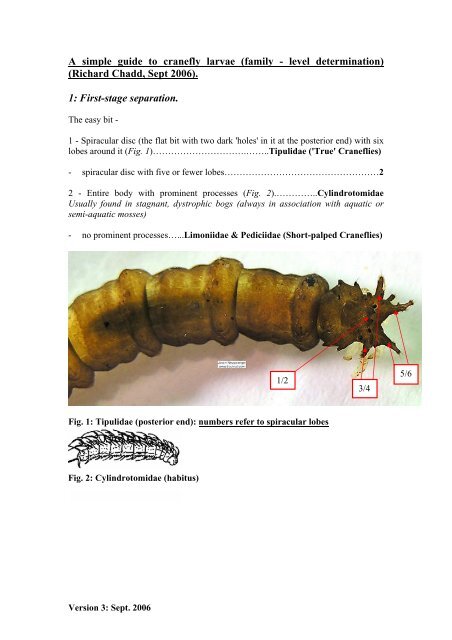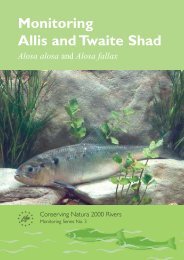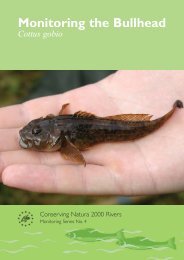A simple guide to cranefly larvae (family - level ... - FreshwaterLife
A simple guide to cranefly larvae (family - level ... - FreshwaterLife
A simple guide to cranefly larvae (family - level ... - FreshwaterLife
Create successful ePaper yourself
Turn your PDF publications into a flip-book with our unique Google optimized e-Paper software.
A <strong>simple</strong> <strong>guide</strong> <strong>to</strong> <strong>cranefly</strong> <strong>larvae</strong> (<strong>family</strong> - <strong>level</strong> determination)<br />
(Richard Chadd, Sept 2006).<br />
1: First-stage separation.<br />
The easy bit -<br />
1 - Spiracular disc (the flat bit with two dark 'holes' in it at the posterior end) with six<br />
lobes around it (Fig. 1)………………………….……..Tipulidae ('True' Craneflies)<br />
- spiracular disc with five or fewer lobes……………………………………………2<br />
2 - Entire body with prominent processes (Fig. 2).…………..Cylindro<strong>to</strong>midae<br />
Usually found in stagnant, dystrophic bogs (always in association with aquatic or<br />
semi-aquatic mosses)<br />
- no prominent processes…...Limoniidae & Pediciidae (Short-palped Craneflies)<br />
Fig. 1: Tipulidae (posterior end): numbers refer <strong>to</strong> spiracular lobes<br />
Fig. 2: Cylindro<strong>to</strong>midae (habitus)<br />
Version 3: Sept. 2006<br />
1/2<br />
3/4<br />
5/6
2: Second-stage separation.<br />
The slightly trickier bit -<br />
There are five genera of Pediciidae in Northern Europe: Dicranota, Pedicia,<br />
Tricyphona, Ula and Nasiternella. The latter is not a British species and Ula lives in<br />
fungi. The remaining three have two cylindrical lobes on the anal segment. The<br />
only other genus with this feature is An<strong>to</strong>cha (formerly Taphrophila), which is a<br />
limoniid, but does not possess any spiracles (two dark 'holes') on the anal<br />
segment (and lives in a silk tube).<br />
So, having used the key above <strong>to</strong> separate Tipulidae, Cylindro<strong>to</strong>midae and<br />
Limoniidae/Pediciidae, separate the latter pair as follows:<br />
1 - two obvious, cylindrical & hairless posterior lobes present (Figs. 3 & 4)……….2<br />
- one posterior lobe (Fig. 5), or apparently 2 flattened lobes, with a thick tuft of<br />
hair (see note* below) or 4 <strong>to</strong> 5 obvious lobes present (Fig.<br />
6)……………………………………….Limoniidae (except An<strong>to</strong>cha vitripennis)<br />
2 - spiracles present……………………………Pediciidae (G: Dicranota, Pedicia<br />
and Tricyphona)<br />
- spiracles absent (Fig. 7)………………………Limoniidae (An<strong>to</strong>cha vitripennis<br />
only). Lives in a silken tube, attached <strong>to</strong> s<strong>to</strong>nes in flowing water<br />
*N.B. Genus: Pilaria (F: Limoniidae) is variable, dependent on the speciesgroup:<br />
P. filata gp. possesses only a single, thick lobe, as in Fig. 5.; P. discicollis gp., on<br />
first sight, seems <strong>to</strong> have two lobes. On close examination, however, it actually<br />
has 2, well-separated & obvious lobes, plus two additional lobes which are closely<br />
opposed <strong>to</strong> the bases of the other two & fairly small. The whole lot is swathed in<br />
thick hair, which sticks out as a single tuft in P. filata gp., and as two tufts in<br />
P.discicollis gp. (P. nemoralis gp. is very obviously 4-lobed, with a rudimentary<br />
5 th dorsal lobe).<br />
So, only follow the first part of this couplet (<strong>to</strong> couplet 2) if you have two obvious,<br />
hairless & cylindrical lobes, as in Figs. 3, 4 and 7. If you have a lot of hair<br />
growing from the lobes, look carefully, and what you think is two lobes is<br />
actually 4, and is therefore a limoniid. The lobes tend <strong>to</strong> be slightly flattened in<br />
this case.<br />
Version 3: Sept. 2006
Fig. 3: Dicranota sp. (Pediciidae) - 2 lobes, plus 2 spiracles<br />
Version 3: Sept. 2006<br />
Fig. 4: Dicranota sp. (habitus) - 2 lobes plus<br />
2 spiracles
Version 3: Sept. 2006<br />
Fig. 5: Pilaria sp.<br />
(Limoniidae) - Single lobe,<br />
with single hair-tuft. May<br />
also appear <strong>to</strong> have 2<br />
lobes, but has two smaller<br />
additional lobes. Always<br />
very hairy.<br />
Fig. 6: Eloeophila sp./Hexa<strong>to</strong>ma<br />
sp. (Limoniidae) - 4 lobes, (note 2<br />
spiracles, same position as in<br />
Dicranota & Pedicia)
Fig. 7: An<strong>to</strong>cha vitripennis - 2 lobes and no spiracles<br />
3: Final thought.<br />
If you obtain specimens of limoniids or pediciids, at least 90% of the time, the genera<br />
you will find will be Dicranota (Pediciidae), Eloeophila (Limoniidae) and Pilaria<br />
(Limoniidae), all of which are illustrated above. If all else fails, just look at the<br />
pictures!<br />
Occasionally, you will get others, such as Pedicia and Hexa<strong>to</strong>ma, but the key above<br />
will allow for these. If you feel like a bit of stimulation (and have an inclination<br />
<strong>to</strong>wards actually producing data for some 'biodiversity' purpose) try using Nilsson or<br />
Brindle <strong>to</strong> take your specimens <strong>to</strong> genus <strong>level</strong> (in some cases, such as An<strong>to</strong>cha, this<br />
allows a species determinations <strong>to</strong> be made. Several are Red Data).<br />
Version 3: Sept. 2006
















